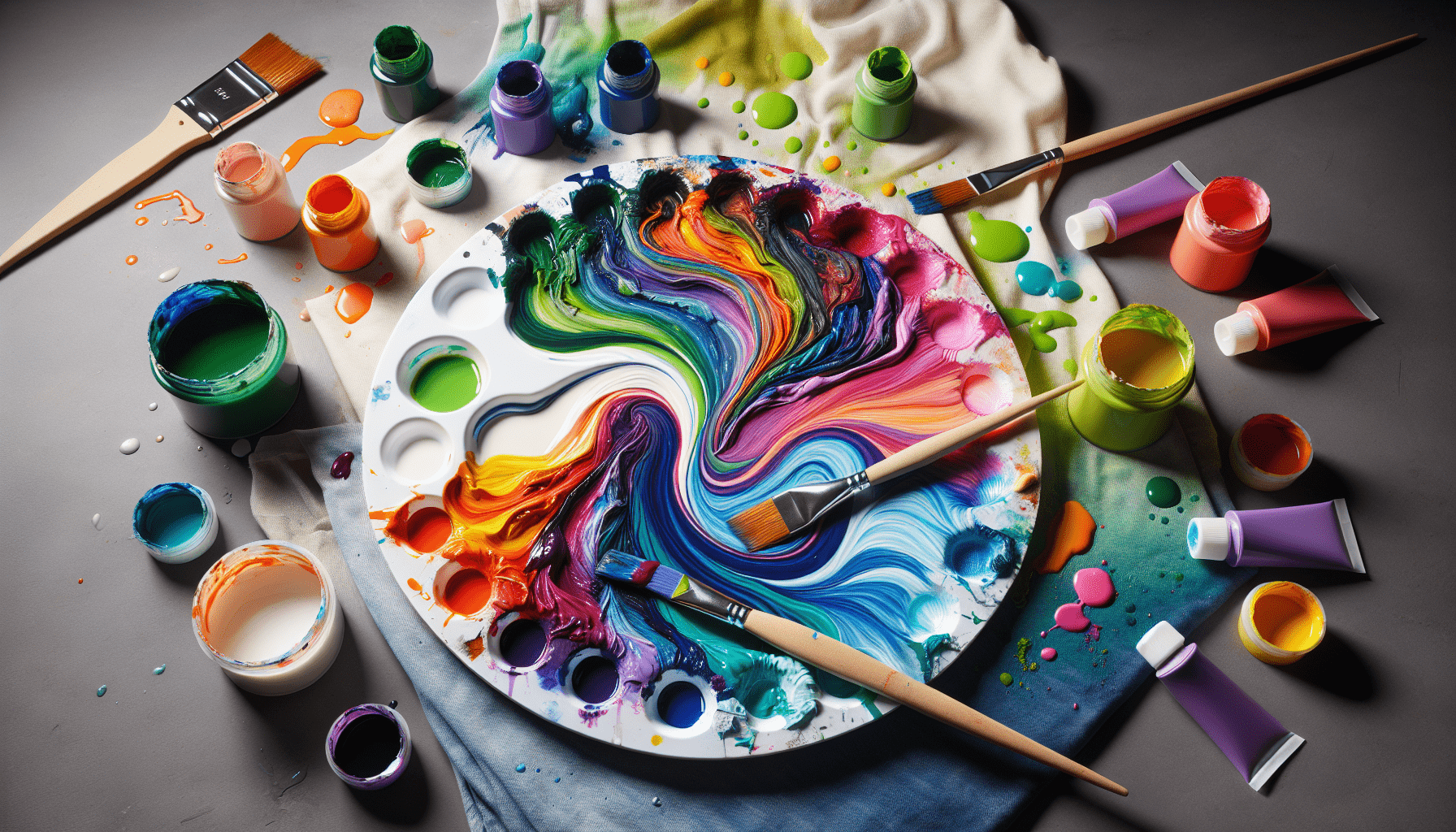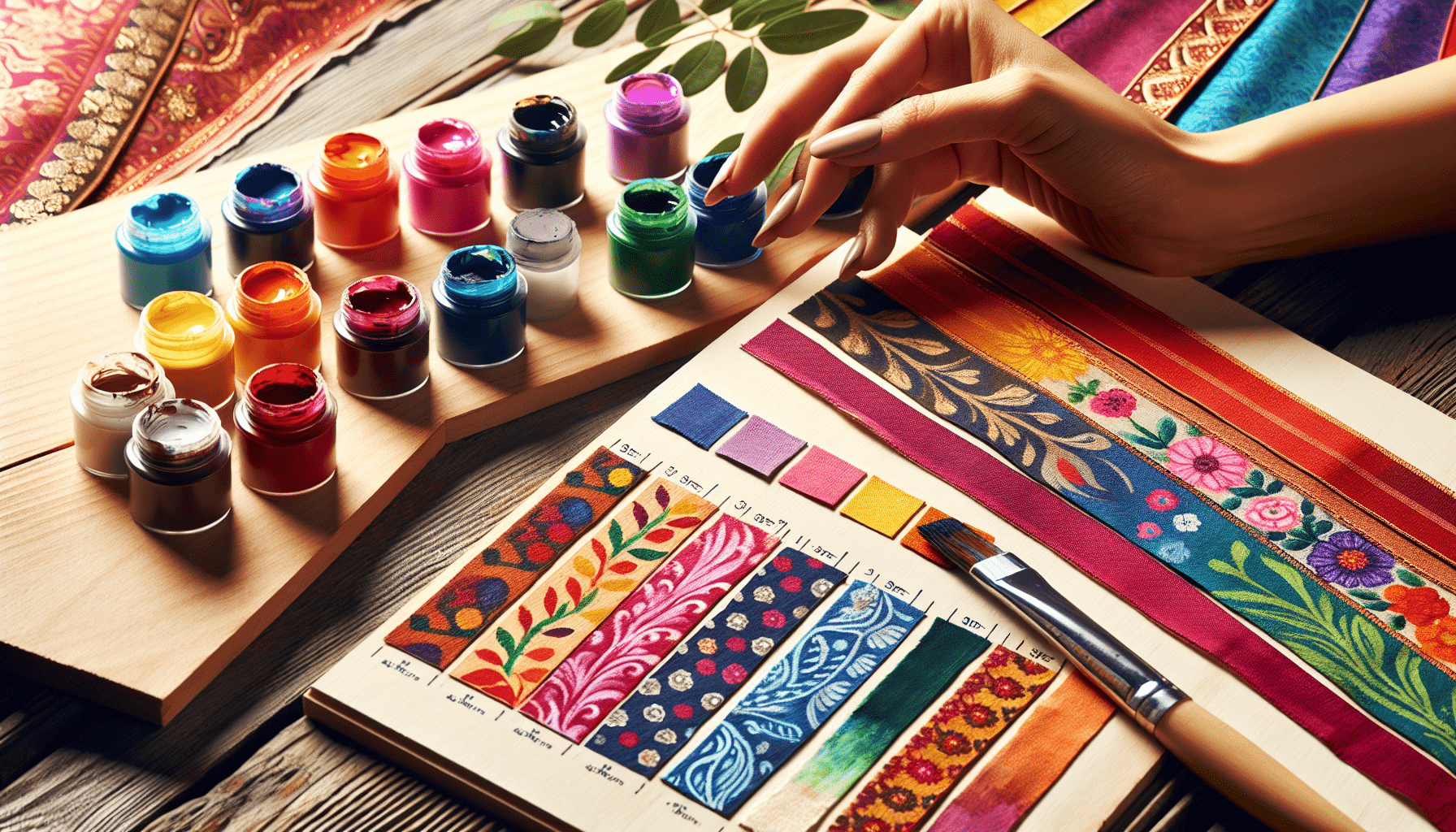In this article, you will discover a simple yet effective method to transform your acrylic paint into fabric paint without the need for any additional medium. By following this technique, you can easily customize your clothing and accessories with vibrant and long-lasting designs, expanding your creative possibilities without having to invest in costly fabric paints. Whether you’re a professional artist or a crafting enthusiast, this step-by-step guide will provide you with the knowledge and insights necessary to achieve stunning results on fabric using acrylic paint alone.
Preparation
Before you begin the process of turning acrylic paint into fabric paint, it’s important to gather all the necessary materials. You will need acrylic paint in your desired color, a mixing surface, a paintbrush, fabric softener, white vinegar, glycerin, hair conditioner, and the fabric you plan to paint on.
Next, clean and prepare your fabric by washing it properly. This will remove any dirt, residue, or sizing that might interfere with the paint’s adherence to the fabric. Make sure to follow the fabric’s care instructions and use any recommended pre-washing methods to ensure the best paint application.
Mixing
Once you have gathered your materials and prepared your fabric, it’s time to mix the acrylic paint to create your fabric paint. Start by choosing the acrylic paint color you want to use for your project. Acrylic paints come in a wide range of colors, allowing you to explore various creative possibilities.
Prepare a suitable mixing surface, such as a disposable palette or a plastic plate, where you can mix your paints. This surface should be easy to clean and provide enough space for proper mixing.
To create the fabric paint, mix equal parts of acrylic paint and water together. This mixture will help thin out the paint and make it easier to apply evenly on the fabric. It’s crucial to achieve the right consistency, so your paint glides smoothly on the fabric without being too thick or watery.
After mixing the paint and water, it’s essential to test the consistency. Dip your paintbrush into the mixture and apply it to a small scrap piece of fabric or an inconspicuous area on your project. Observe how the paint spreads and how transparent or opaque it appears. Adjust the paint-to-water ratio as needed until you achieve the desired consistency for your project.

Application
Once you have created your fabric paint, it’s time to apply it to the fabric. Using a clean paintbrush, dip it into the mixture and begin applying the paint to the desired areas of your fabric. Make sure to apply an even coat of paint, ensuring full coverage without any thin spots or streaks.
After you have applied the paint, it’s crucial to let it dry completely. The drying time will vary depending on the thickness of your paint and the fabric type. Follow the drying instructions provided by the acrylic paint manufacturer, or let the fabric air dry for a sufficient amount of time.
To enhance the durability and longevity of your fabric paint, it’s recommended to heat set it. Heat setting involves applying heat to the painted fabric to help the paint bond securely. Place a cloth over the painted area and use a dry iron on a low setting to apply heat, following the specific instructions provided by the acrylic paint manufacturer.
Alternative Mixing Methods
If you prefer not to mix your acrylic paint with water or want to experiment with different mixing techniques, there are alternative methods to create fabric paint without using water.
One method involves using fabric softener. Mix fabric softener with your acrylic paint, using a 1:1 ratio, to create a smooth and flexible fabric paint. This mixture can provide a softer feel to the painted fabric.
Another alternative is to use white vinegar in place of water. Mix equal parts white vinegar and acrylic paint to create a fabric paint mixture. The vinegar helps to bind the paint to the fabric fibers, increasing its longevity and washability.
Glycerin can also be used as a mixing medium. By mixing glycerin with your acrylic paint, you can achieve a softer, more pliable fabric paint that retains flexibility even after it dries.
Finally, if you have hair conditioner on hand, you can mix it with acrylic paint to create fabric paint. The hair conditioner acts as a fabric softener and gives the paint a smoother, more spreadable texture.
Experiment with these alternative mixing methods to find the one that best suits your desired results and fabric painting preferences.

Fabric Compatibility
When using acrylic paint as fabric paint, it’s important to consider the type of fabric you are working with. Different fabrics have different absorbencies and textures, which can affect how the paint adheres and appears on the fabric.
Before applying the paint to your fabric, consider its fiber content and weave. Fabrics such as cotton, linen, and canvas tend to take acrylic paint well due to their absorbent nature. On the other hand, synthetic fabrics like polyester and nylon may require additional preparation, such as washing with a fabric softener or heat-setting for better paint adhesion.
If you are working with a new fabric, it’s essential to pre-wash it before painting. This step will remove any sizing or chemicals from the fabric and ensure better paint absorption. Follow the fabric’s care instructions to wash it properly, and avoid using any fabric softeners or dryer sheets, as they can create a barrier on the fabric’s surface.
To avoid any surprises, test your fabric paint on a small, inconspicuous area of the fabric before applying it to the entire project. This test will allow you to evaluate how the paint interacts with the fabric and gives you the opportunity to make any necessary adjustments before committing to the full application.
Tips and Tricks
Working with fabric paint can be a rewarding experience, but it’s important to keep certain tips and tricks in mind to achieve the best results possible.
First and foremost, always work in a well-ventilated area. Acrylic paint contains fumes that can be harmful if inhaled in large quantities. Open windows or use fans to ensure proper airflow while you paint.
Protect your work surface by using a plastic tablecloth or craft mat. Acrylic paint can stain surfaces, and having a protective layer will make cleanup much more manageable.
When selecting fabrics for your painting projects, consider using lighter-colored fabrics. Lighter fabrics provide better visibility for the paint color and allow you to see the true hue and saturation of your artwork.
Experiment with different paint-to-water ratios to achieve various effects. Adding more water to your acrylic paint mixture will create a more translucent and watercolor-like appearance, while less water will result in a more opaque and solid coverage.
Fixing Mistakes
Mistakes can happen during the painting process, but there are methods to fix them depending on the stage of the project and the type of mistake made.
If you make a mistake while the paint is still wet, it’s crucial to act quickly. Dampen a clean cloth or sponge with water and gently blot the area, removing as much of the wet paint as possible. Avoid rubbing or scrubbing, as this can spread the paint and make the mistake more noticeable.
In the case of mistakes that have already dried, it’s essential to let the fabric fully dry before attempting to fix them. Once the paint is dry, you can use fabric markers to make small touch-ups or corrections. Choose a fabric marker that closely matches the color of your fabric paint and make precise adjustments to conceal any mistakes.
Washing the Fabric
After you have completed your fabric painting project, it’s essential to take appropriate steps to ensure the longevity and durability of your artwork when washing the fabric.
First, it’s recommended to wait at least 72 hours before washing the painted fabric. This waiting period allows the paint to fully cure and bond with the fabric fibers, ensuring better washability.
When washing fabric items that have been painted, turn them inside out. This will help protect the painted surface from excessive friction and rubbing against other fabrics or items in the washing machine.
Use a gentle cycle and cold water when washing painted fabric. Harsh agitation and high heat can diminish the paint’s vibrancy and cause it to crack or peel over time. Mild detergents specifically designed for delicate fabrics are preferred, as they are less likely to be abrasive to the painted surface.
Avoid using bleach or harsh detergents when washing painted fabric. These chemicals can strip away the paint and affect its color or integrity. It’s best to choose gentle, fabric-friendly products that will preserve the quality of your painted designs.
Durability and Care
While acrylic fabric paint can be long-lasting, it’s essential to recognize that some fading may occur over time. Factors such as exposure to sunlight, frequent washing, and environmental conditions can contribute to the gradual fading of fabric paint. To maintain the vibrancy of your painted fabric, it’s advisable to store it away from direct sunlight when not in use and follow proper washing and care guidelines.
To avoid unnecessary wear and tear, it’s important to avoid excessive friction or rubbing of painted fabric. Be mindful when washing or handling the fabric to prevent any damage or premature fading of the artwork.
If your painted fabric requires ironing, it’s recommended to do so on the reverse side. Ironing on the reverse side helps protect the painted surface from direct heat and prevents any accidental smudging or transfer of paint onto the iron or ironing board.
When not in use, store your fabric items properly to maintain their quality and longevity. Fold or roll the fabric neatly and store it in a clean, dry place away from moisture and extreme temperature fluctuations. This will help preserve the paint’s integrity and prevent any unnecessary damage.
Benefits and Limitations
Turning acrylic paint into fabric paint without a medium offers several benefits and creative opportunities. One of the advantages is cost-effectiveness. Acrylic paints are generally less expensive than store-bought fabric paints, making them an economical choice for various painting projects.
Additionally, using acrylic paint allows for a wider range of color options. Acrylic paints come in a vast array of shades and hues, giving artists the freedom to create any desired color or color combination for their fabric painting projects.
Despite these benefits, it’s important to note that homemade fabric paint may have less durability compared to store-bought fabric paint. Store-bought fabric paints often contain additional binders and mediums specifically formulated for fabric, ensuring better adhesion, washability, and color retention. While homemade fabric paint can be long-lasting with proper care, it may have a slightly shorter lifespan than commercially manufactured fabric paints.
In conclusion, turning acrylic paint into fabric paint without a medium is a versatile and accessible way to enhance your fabric artistry. By following the steps outlined in this article, you can create custom fabric paints, unleash your creativity, and add vibrant designs to various fabric surfaces. With careful selection of materials, proper mixing and application techniques, and thorough care and maintenance, your fabric painting projects can be enjoyable, durable, and visually stunning.



